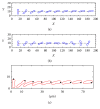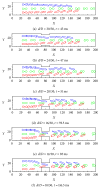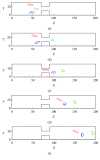Numerical Simulations of the Motion and Deformation of Three RBCs during Poiseuille Flow through a Constricted Vessel Using IB-LBM
- PMID: 29681999
- PMCID: PMC5841101
- DOI: 10.1155/2018/9425375
Numerical Simulations of the Motion and Deformation of Three RBCs during Poiseuille Flow through a Constricted Vessel Using IB-LBM
Abstract
The immersed boundary-lattice Boltzmann method (IB-LBM) was used to examine the motion and deformation of three elastic red blood cells (RBCs) during Poiseuille flow through constricted microchannels. The objective was to determine the effects of the degree of constriction and the Reynolds (Re) number of the flow on the physical characteristics of the RBCs. It was found that, with decreasing constriction ratio, the RBCs experienced greater forced deformation as they squeezed through the constriction area compared to at other parts of the microchannel. It was also observed that a longer time was required for the RBCs to squeeze through a narrower constriction. The RBCs subsequently regained a stable shape and gradually migrated toward the centerline of the flow beyond the constriction area. However, a sick RBC was observed to be incapable of passing through a constricted vessel with a constriction ratio ≤1/3 for Re numbers below 0.40.
Figures















Similar articles
-
Numerical simulation of red blood cell behavior in a stenosed arteriole using the immersed boundary-lattice Boltzmann method.Int J Numer Method Biomed Eng. 2012 Feb;28(2):239-56. doi: 10.1002/cnm.1463. Epub 2011 Aug 23. Int J Numer Method Biomed Eng. 2012. PMID: 25099328
-
Numerical simulation of transient dynamic behavior of healthy and hardened red blood cells in microcapillary flow.Int J Numer Method Biomed Eng. 2016 Nov;32(11). doi: 10.1002/cnm.2763. Epub 2016 Jan 20. Int J Numer Method Biomed Eng. 2016. PMID: 26729644
-
Numerical simulation of motion and deformation of healthy and sick red blood cell through a constricted vessel using hybrid lattice Boltzmann-immersed boundary method.Comput Methods Biomech Biomed Engin. 2017 May;20(7):737-749. doi: 10.1080/10255842.2017.1298746. Epub 2017 Mar 3. Comput Methods Biomech Biomed Engin. 2017. PMID: 28387168
-
Numerical simulations of deformation and aggregation of red blood cells in shear flow.Crit Rev Biomed Eng. 2013;41(4-5):425-34. doi: 10.1615/critrevbiomedeng.2014010689. Crit Rev Biomed Eng. 2013. PMID: 24941417 Review.
-
A review of numerical methods for red blood cell flow simulation.Comput Methods Biomech Biomed Engin. 2015;18(2):130-40. doi: 10.1080/10255842.2013.783574. Epub 2013 Apr 14. Comput Methods Biomech Biomed Engin. 2015. PMID: 23582050 Review.
Cited by
-
An Explicit-Correction-Force Scheme of IB-LBM Based on Interpolated Particle Distribution Function.Entropy (Basel). 2023 Mar 17;25(3):526. doi: 10.3390/e25030526. Entropy (Basel). 2023. PMID: 36981414 Free PMC article.
References
-
- Xu Y.-Q., Tian F.-B., Deng Y.-L. An efficient red blood cell model in the frame of IB-LBM and its application. International Journal of Biomathematics. 2013;6(1):1–22. doi: 10.1142/s1793524512500611.1250061 - DOI
-
- Tsubota K.-I., Wada S. Elastic force of red blood cell membrane during tank-treading motion: Consideration of the membrane's natural state. International Journal of Mechanical Sciences. 2010;52(2):356–364. doi: 10.1016/j.ijmecsci.2009.10.007. - DOI
MeSH terms
LinkOut - more resources
Full Text Sources
Other Literature Sources

